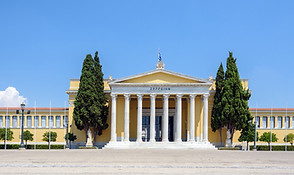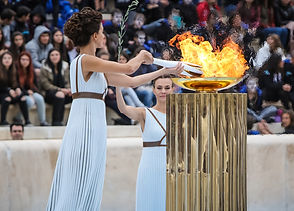SIGHTSEEING

Acropolis & Acropolis Museum
The Acropolis of Athens is an ancient citadel located on a rocky outcrop above the city of Athens and contains the remains of several ancient buildings of great architectural and historic significance, the most famous being the Parthenon. The word acropolis is from the Greek words ἄκρον (akron, "highest point, extremity") and πόλις (polis, "city").
The Acropolis Museum was founded in 2003, while the Organization of the Museum was established in 2008 and opened to the public on 20 June 2009. It is focused on the findings of the archaeological site of the Acropolis of Athens. The museum was built to house every artifact found on the rock and on the surrounding slopes, from the Greek Bronze Age to Roman and Byzantine Greece.
Nearly 4,000 objects are exhibited over an area of 14,000 square metres.
(Metro Station: Acropolis)

Zappeion Megaron & National Garden
The Zappeion is a building in the National Gardens of Athens in the heart of the city.
It is generally used for meetings and ceremonies, both official and private.
The Zappeion was used during the 1896 Summer Olympics as the main fencing hall. A decade later, at the 1906 Intercalated Games, it was used as the Olympic Village.
A number of historical events have taken place at the Zappeion, including the signing of the documents formalizing Greece's accession to the European Community in May, 1979.
The Zappeion is currently being used as a Conference and Exhibition Center for both public and private purposes.
Next to Zappeion Megaron there is the National Gadern, a public park of 15.5 hectares and a breath of fresh air for you to visit! From the moment you step in the gardens, you feel like you have entered a different place and time.
The Royal Garden was commissioned by Queen Amalia in 1838 and completed by 1840. It was designed by the German agronomist Friedrich Schmidt who imported over 500 species of plants and a variety of animals including peacocks, ducks and turtles. In the 1920s the park was opened to the public and renamed "National Garden".

Mount Lycabettus
Mount Lycabettus is a Cretaceous limestone hill in Athens, at 300 meters (908 feet) above sea level. Pine trees cover its base, and at its two peaks are the 19th century Chapel of St. George, a theatre and a restaurant.
The hill is a tourist destination and can be ascended by the Lycabettus Funicular, a funicular railway which climbs the hill from a lower terminus at Kolonaki (The railway station can be found at Aristippou street).
The hill has a large open-air amphitheatre at the top, which has housed many Greek and international concerts.

Theatre of Dionysus and
Odeon of Herodes Atticus
The Theatre of Dionysus Eleuthereus is a major theatre in Athens, considered to be the world's first theatre, built at the foot of the Athenian Acropolis.
Dedicated to Dionysus, the god of plays and wine (among other things), the theatre could seat as many as 17,000 people with excellent acoustics, making it an ideal location for ancient Athens' biggest theatrical celebration, the Dionysia.
It was the first theatre ever built, cut into the southern cliff face of the Acropolis, and supposedly the birthplace of Greek tragedy. The remains of a restored and redesigned Roman version can still be seen at the site today.
It is sometimes confused with the later, smaller, and better-preserved Odeon of Herodes Atticus, located nearby on the southwest slope of the Acropolis.
The Odeon of Herodes Atticus is a stone theatre structure located on the southwest slope of the Acropolis of Athens. The building was built in 161 AD by the Athenian magnate Herodes Atticus. It was originally a steep-sloped theater with a three-story stone front wall and a wooden roof made of expensive cedar of Lebanon timber. It was used as a venue for music concerts with a capacity of 5,000. It lasted intact until it was destroyed and left in ruins by the Heruli in 267 AD.
(Metro Station: Acropolis)

The Presidental Mansion
The Presidential Mansion is the official residence of the President of the Hellenic Republic. It served previously as the Royal Palace until the abolition of the monarchy by referendum in 1973.
The Presidential Mansion with its garden occupies a total area of about 27,000 square metres (about 7 acres). The official entrance to the Mansion is on Herodou Attikou Street.
Syntagma Square
Syntagma Square is the central square of Athens. It is located in front of the 19th century Old Royal Palace, housing the Greek Parliament since 1934.
Syntagma Square is the most important square of modern Athens from both a historical and social point of view, at the heart of commercial activity and Greek politics. The name Syntagma alone also refers to the neighbourhood surrounding the square.
Syntagma also includes two green areas to the north and south, planted with shade trees, while in the centre of the square there is a large mid-19th century water fountain.
The Old Royal Palace neoclassical building, housing the Greek Parliament since 1934, is immediately across Amalias Avenue to the east, and
surrounded by the extensive National Gardens, which are open to the public.
Every hour, the changing of the guard ceremony, performed by the Presidential Guard, is conducted in front of the Tomb of the Unknown Soldier on the area between the Syntagma Square and Parliament building.
The Square is located near many of Athens' oldest and most famous neighbourhoods and tourist attractions (all within walking distance), such as Plaka, Psirri. Monastiraki, Kolonaki, etc.
(Metro Station: Syntagma)

Kallimarmaro
The Panathenaic Stadium or Kallimarmaro is a multi-purpose stadium. One of the main historic attractions of Athens, it is the only stadium in the world built entirely of marble.
It was built on the site of a simple racecourse by the Athenian statesman Lykourgos c. 330 BC, primarily for the Panathenaic Games. It was rebuilt in marble by Herodes Atticus, an Athenian Roman senator, by 144 AD and had a capacity of 50,000 seats. After the rise of Christianity in the 4th century it was largely abandoned. The stadium was excavated in 1869 and hosted the Zappas Olympics in 1870 and 1875. After being refurbished, it hosted the opening and closing ceremonies of the first modern Olympics in 1896.
It was used for various purposes in the 20th century and was once again used as an Olympic venue in 2004.
It is the finishing point for the annual Athens Classic Marathon. It is also the last venue in Greece from where the Olympic flame handover ceremony to the host nation takes place.

The Ancient Agora of Athens
The Ancient Agora of Classical Athens is the best-known example of an ancient Greek agora, located to the northwest of the Acropolis.
Museum of Ancient Agora: The museum is housed in the Stoa of Attalos, and its exhibits are connected with the Athenian democracy. The collection of the museum includes clay, bronze and glass objects, sculptures, coins and inscriptions from the 7th to the 5th century BCE, as well as pottery of the Byzantine period and the Turkish occupation. The exhibition within the museum contains work of art which describes the private and public life in ancient Athens
(Metro Station: Acropolis)
Plaka
Pláka is the old historical neighborhood of Athens, clustered around the northern and eastern slopes of the Acropolis (between Syntagma and Monastiraki square), and incorporating labyrinthine streets and neoclassical architecture. Plaka is built on top of the residential areas of the ancient town of Athens. It is known as the "Neighborhood of the Gods" due to its proximity to the Acropolis and its many archaeological sites.
Museums in Plaka include the
new Acropolis Museum, the new Jewish Museum of Greece, the Museum of Greek Folk Art, an annex of which is the Old Public Baths building, the Frissiras Museum, the Museum of Popular Music Instruments, the Museum of Pavlos and Alexandra Kanellopoulou and the Athens University Museum.
Plaka is visited by hundreds of thousands of tourists around the year.
(Metro Station: Syntagma)

..other archaeological sites
Don't forget to visit them!
• Philopappou Hill
• National Museum of Modern Art
• Roman Agora
• Kerameikos Cemetery
• Adrian's arch
